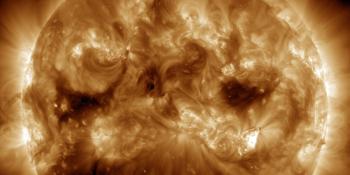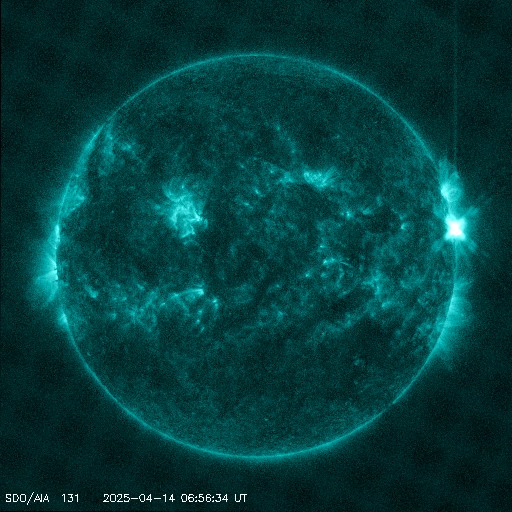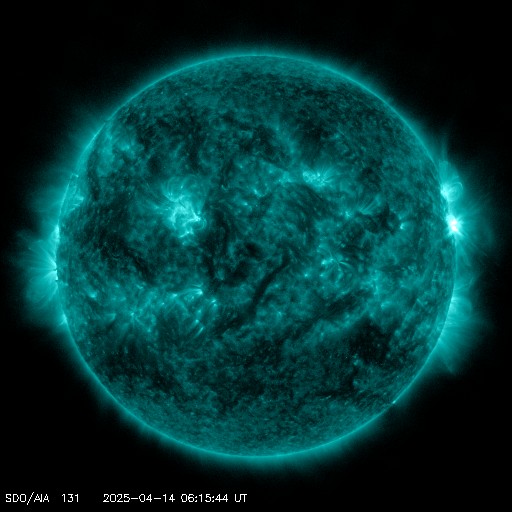Viewing archive of Saturday, 1 February 2003
Solar activity report
Any mentioned solar flare in this report has a scaling factor applied by the Space Weather Prediction Center (SWPC). Because of the SWPC scaling factor, solar flares are reported as 42% smaller than for the science quality data. The scaling factor has been removed from our archived solar flare data to reflect the true physical units.
Report of Solar-Geophysical Activity 2003 Feb 01 2200 UTCPrepared by the NOAA © SWPC and processed by SpaceWeatherLive.com
Joint USAF/NOAA Report of Solar and Geophysical Activity
SDF Number 032 Issued at 2200Z on 01 Feb 2003IA. Analysis of Solar Active Regions and Activity from 31-2100Z to 01-2100Z
Solar activity was moderate during the past 24 hours.
All of today's flare activity was dominated by new Region 276
(S14E76), which produced an M1 at 0905 UTC, a C9/Sf at 1954 UTC, as
well as numerous additional C-class subflares. Observations of the
group so far indicate a relatively small (190 millionths) D-type
sunspot group. An erupting prominence was observed at 31/2200 UTC on
the Northwest limb and was associated with a type II sweep (shock
velocity 500 km/s) and a CME seen by LASCO. The remainder of the
regions on the disk were quiet and stable.
IB. Solar Activity Forecast
Solar activity is expected to be low
to moderate. Region 276 is expected to be the main driver of
activity, and has a fair chance for producing an additional M-class
event over the next three days.
IIA. Geophysical Activity Summary 31-2100Z to 01-2100Z
The geomagnetic field ranged from quiet to active levels during the
past 24 hours. Quiet conditions prevailed for most of the day, but
an increase to unsettled to active began at 1500 UTC. A marked
increase in solar wind velocity and total magnetic field strength
was observed beginning at 1300 UTC, but a predominantly positive
value for Bz suppressed activity until 1900 UTC, when Bz turned
weakly southwards. The interpretation of the enhanced solar wind
flow is not obvious, but seems most consistent with the passage of
transient flow due to the halo CME that occurred on 30 January. The
great than 2 MeV electron fluxes reached high levels during the past
24 hours.
IIB. Geophysical Activity Forecast
The geomagnetic field is
expected to be mostly active for the next 24 hours with a chance for
some isolated minor storm periods. Conditions should subside to
unsettled to active by day two, and return to mostly unsettled
levels by the third day.
III. Event Probabilities 02 Feb to 04 Feb
| Class M | 35% | 35% | 35% |
| Class X | 05% | 05% | 05% |
| Proton | 01% | 01% | 01% |
| PCAF | green | ||
IV. Penticton 10.7 cm Flux
Observed 01 Feb 126 Predicted 02 Feb-04 Feb 130/135/140 90 Day Mean 01 Feb 156
V. Geomagnetic A Indices
Observed Afr/Ap 31 Jan 011/018 Estimated Afr/Ap 01 Feb 012/015 Predicted Afr/Ap 02 Feb-04 Feb 025/025-015/020-010/015
VI. Geomagnetic Activity Probabilities 02 Feb to 04 Feb
| A. Middle Latitudes | |||
|---|---|---|---|
| Active | 35% | 30% | 25% |
| Minor storm | 30% | 20% | 15% |
| Major-severe storm | 15% | 05% | 01% |
| B. High Latitudes | |||
|---|---|---|---|
| Active | 35% | 35% | 20% |
| Minor storm | 40% | 30% | 10% |
| Major-severe storm | 20% | 10% | 05% |
All times in UTC
Current data suggests there is a slight possibility for aurora to appear at the following high latitude regions in the near future
Gillam, MBLatest news
Latest forum messages
2025/04/12-13 Filament CMEs 2025/04/16 G2 Watch 45Incoming & Unnumbered Active Regions 1708Filaments and prominences 61AR 4055 99Unspecified geomagnetic activity 2258
More topicsSupport SpaceWeatherLive.com!
A lot of people come to SpaceWeatherLive to follow the Sun's activity or if there is aurora to be seen, but with more traffic comes higher server costs. Consider a donation if you enjoy SpaceWeatherLive so we can keep the website online!

Latest alerts
Monday, 14 April 2025
23:15 UTC - Geomagnetic activity
Active geomagnetic conditions (Kp4) Threshold Reached: 23:01 UTC
07:09 UTC - Solar flare
Moderate M4.28 flare from sunspot region 4055
06:48 UTC - Radio Blackout
Minor R1 radio blackout in progress (≥M1 - current: M1.53)
06:24 UTC - Solar flare
Moderate M1.49 flare from sunspot region 4055
06:06 UTC - Radio Blackout
Minor R1 radio blackout in progress (≥M1 - current: M1.16)
Space weather facts
| Last X-flare | 2025/03/28 | X1.1 |
| Last M-flare | 2025/04/14 | M4.2 |
| Last geomagnetic storm | 2025/04/06 | Kp5 (G1) |
| Spotless days | |
|---|---|
| Last spotless day | 2022/06/08 |
| Monthly mean Sunspot Number | |
|---|---|
| March 2025 | 134.2 -20.4 |
| April 2025 | 132.1 -2.1 |
| Last 30 days | 130.6 -13.6 |





